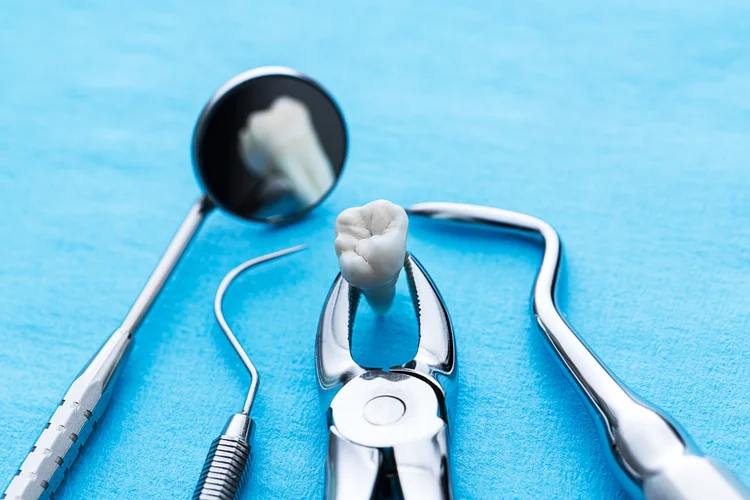The main difference between wisdom tooth extraction and surgery lies in the
complexity of the procedure required to remove the tooth.
Wisdom tooth extraction refers to the straightforward
removal of a fully erupted tooth, which is visible above the gum line.
Conversely, wisdom tooth surgery involves a more complex
procedure typically necessary when the tooth is impacted, partially erupted,
or difficult to access due to its positioning below the gum line or within
the jawbone.
In this article, we outline key differences between wisdom tooth extraction
and surgery, including recommended situations, procedure details, recovery,
risks, and associated costs in Singapore.

| Key Differences | Wisdom Tooth Extraction | Wisdom Tooth Surgery |
|---|---|---|
| Recommended For |
|
|
| Complexity |
|
|
| Recovery |
|
|
| Risks |
|
|
| Cost |
|
|
When Is Wisdom Tooth Extraction Suitable?
Wisdom tooth extraction is suitable when the tooth has fully erupted above the gum line and can be easily accessed by a dentist. Common reasons to undergo a simple extraction include:
- Tooth decay or cavities affecting the wisdom tooth.
- Gum disease around the wisdom tooth.
- Crowding leading to alignment issues.
- Difficulty maintaining proper oral hygiene due to tooth position.
When Is Wisdom Tooth Surgery Necessary?
Wisdom tooth surgery becomes necessary when teeth are impacted, partially erupted, or positioned in a manner that prevents simple extraction. Common situations requiring surgical extraction include:
- Impaction – Teeth trapped beneath gum tissue or embedded within the jawbone.
- Partial eruption – Teeth that have only partially emerged through the gums, increasing the risk of infection and inflammation.
- Severe crowding – Teeth positioned in ways that negatively affect nearby teeth or overall alignment.
What Does Each Procedure Involve?
Wisdom Tooth Extraction Procedure
Wisdom tooth extraction involves a series of straightforward steps designed to remove a fully erupted tooth with minimal disruption:
- Local anaesthesia is administered to numb the area.
- Specialised dental instruments are used to gently loosen and remove the tooth.
- The extraction site is thoroughly cleaned to prevent infection.
- Gauze is placed over the site to manage bleeding and promote clot formation.

Wisdom Tooth Surgery Procedure
Wisdom tooth surgery includes additional steps due to complexity:
- Local anaesthesia or sedation is administered, depending on the complexity of the case and patient preference.
- A precise incision is made in the gum tissue to expose the tooth and surrounding bone.
- Any bone blocking access to the tooth is carefully removed if necessary.
- The tooth may be divided into smaller sections to facilitate easier removal.
- The surgical site is cleaned, and stitches are placed to close the incision.
- Gauze is applied to help control bleeding and support the initial stages of healing.
WhatsApp Us Now
How Do Recovery and Aftercare Differ?
Recovery from wisdom tooth extraction generally involves less discomfort and
faster healing compared to recovery from surgery.
For a simple extraction, mild swelling or discomfort
usually lasts for 2 to 3 days. Most patients are able to resume their normal
daily activities within 1 to 2 days. Dietary restrictions are minimal, and
you can typically return to eating their regular meals within 24 to 48
hours.
In contrast, recovery from wisdom tooth surgery is usually
more intensive. Swelling, bruising, and discomfort can last up to a week,
and several days off work or school may be needed for proper healing.
Find out more about wisdom tooth extraction recovery and aftercare in our
comprehensive guide.

What Are the Risks and Complications Associated With Each Procedure?
Both wisdom tooth extraction and surgery carry certain risks, although surgical
procedures tend to involve slightly higher chances of complications due to their
complexity.
Common risks for both procedures include:
- Bleeding.
- Infection at the extraction site.
- Temporary swelling and pain.
- Dry socket, where the protective blood clot dislodges prematurely.
Surgical extraction comes with additional risks such as:
- Prolonged swelling and bruising.
- Nerve injury causing temporary or, in rare cases, permanent numbness or altered sensation.
- Jaw stiffness and difficulty in fully opening the mouth (trismus).
Cost Comparison Between Each Procedure
Wisdom tooth extraction generally incurs lower costs compared to surgical extraction. At True Dental Studio, the costs for wisdom tooth procedures are as follows:
| Procedure | Price* |
|---|---|
| Consultation | $27.25 to $65.40 |
| Wisdom Tooth Extraction | $163.50 to $272.50 |
| Wisdom Tooth Extraction (by Specialist) | $272.50 to $436 |
| Wisdom Tooth Surgery | $981 to $1,362.50 (MediSave-claimable) |
| Wisdom Tooth Surgery (by Specialist) | $1,635 to $2,180 (MediSave-claimable) |
*Prices are NETT and inclusive of GST.
MediSave can
only be used for wisdom tooth surgery in Singapore to cover part or all of the cost,
subject to a maximum of $1,420 claimable per tooth. Simple wisdom tooth extractions
are not MediSave-claimable.
You can also use your MediSave to pay for wisdom tooth surgery for your immediate
family members such as your spouse, children, siblings, parents, grandparents
(parents and grandparents must be a Singapore citizen or Permanent Resident).
Please contact us to learn more about MediSave
eligibility and available financing options.
Book a Wisdom Tooth Consultation With Our Friendly Dentists Today!
Book Wisdom Tooth Appointment
Book NowEnquire More Through Email
Email Us NowEnquire More Through WhatsApp
WhatsApp Us NowWhy Choose True Dental Studio?
Friendly Dentist and Team
Our team treats each and every patient to the best of our ability. This is the reason why entire families have continued their dental care with True Dental Studio for many years, from all over Singapore.
Minimal Discomfort
At True Dental, it is our commitment to ensure our patients are kept as comfortable as possible. We aim to minimize discomfort, if any, for our patients.
Affordable Treatments
We believe in pricing quality treatments at a competitive rate. We are transparent and upfront with our treatment costs.
Our Smile Scorecard
Frequently Asked Questions
Yes, wisdom tooth extraction and surgery differ mainly in complexity. Extraction refers to the simple removal of a fully erupted tooth above the gum line, while surgery involves a more complex procedure to remove an impacted tooth, which is trapped beneath the gum or bone, or a partially erupted tooth, often requiring incisions and bone removal.
Whether wisdom teeth should be pulled or surgically removed depends on their position and condition. Fully erupted teeth are usually pulled through simple extraction, while impacted teeth, which are stuck beneath the gums or bone, or difficult-to-access teeth, require surgical removal to prevent complications and support better recovery outcomes. It is best to consult a dentist or oral surgeon who can examine your wisdom teeth and recommend the most suitable approach.
A wisdom tooth extraction involves the simple removal of a tooth visible above the gum line, requiring minimal intervention. In contrast, a surgical extraction is needed when a tooth is impacted, meaning trapped beneath the gum or bone, partially erupted, or broken below the gum line. It typically involves incisions, possible bone removal, suturing, longer recovery times, and higher costs compared to simple extractions.
Disadvantages of removing wisdom teeth include the cost of the procedure, the time needed for recovery, and temporary disruptions to eating, speaking, and daily activities. Recovery can involve swelling, discomfort, and dietary restrictions for several days. In surgical cases, especially for impacted teeth trapped beneath the gum or bone, the procedure may be more complex, with higher expenses and a longer healing period. However, removal is often recommended when the potential risks of keeping the teeth outweigh these drawbacks.
Impacted wisdom teeth, which are trapped beneath the gum or bone, are generally the hardest to extract, especially when they are tilted, deeply embedded, or positioned near important nerves. These cases often require surgical removal with careful planning to minimise risks such as nerve damage or complications during healing.
Wisdom teeth that are impacted, meaning trapped beneath the gum or bone, partially erupted, or causing dental problems are generally recommended for surgical removal. If you are unsure, it is advisable to consult a dentist or oral surgeon who can assess your condition and recommend the most appropriate approach.
Wisdom teeth removal can feel traumatic because it may involve discomfort, swelling, bleeding, and temporary difficulty in eating or speaking, even with a simple extraction. When surgical steps are needed, such as incisions or bone removal for impacted teeth trapped beneath the gum or bone, recovery can be longer and more intensive. Individual healing responses, anxiety about dental procedures, and the tooth’s position all influence how challenging the experience may feel. Nonetheless, the benefits of removal often outweigh the drawbacks when recommended by a dentist based on your dental condition.
Removing wisdom teeth does not significantly change face shape for most individuals, as these teeth are located at the back of the mouth and do not contribute to the facial profile’s structural support. In rare cases involving extensive surgery or pre-existing swelling, minor temporary changes may occur, but permanent facial changes are uncommon. If you have concerns, it is advisable to discuss them with your dentist or oral surgeon before the procedure.
Wisdom tooth removal can be a simple extraction similar to a routine tooth removal or a surgical procedure, depending on the tooth’s position and complexity. Surgery is typically required when the tooth is impacted, meaning trapped beneath the gum or bone, partially erupted, or difficult to access, requiring incisions or bone removal. The classification depends on how complex it is to reach and remove the tooth safely.
The most painful part of wisdom tooth extraction is often the recovery period rather than the procedure itself, as local anaesthesia, general anaesthesia, or sedation is typically used depending on whether it is a simple extraction or surgery. After the anaesthesia wears off, patients may experience swelling, discomfort, and difficulty eating, especially if bone removal or sutures were involved.
